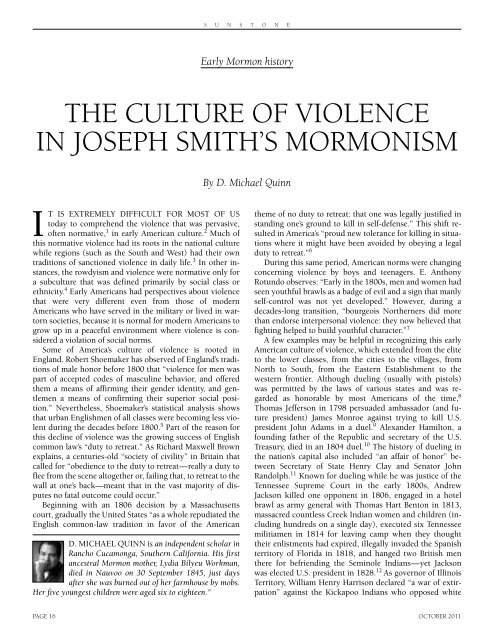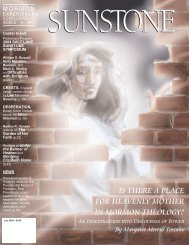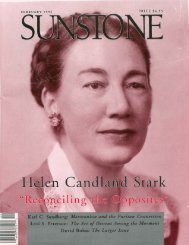Download Entire Issue PDF - Sunstone Magazine
Download Entire Issue PDF - Sunstone Magazine
Download Entire Issue PDF - Sunstone Magazine
You also want an ePaper? Increase the reach of your titles
YUMPU automatically turns print PDFs into web optimized ePapers that Google loves.
S U N S T O N E<br />
Early Mormon history<br />
THE CULTURE OF VIOLENCE<br />
IN JOSEPH SMITH’S MORMONISM<br />
By D. Michael Quinn<br />
IT IS EXTREMELY DIFFICULT FOR MOST OF US<br />
today to comprehend the violence that was pervasive,<br />
often normative, 1 in early American culture. 2 Much of<br />
this normative violence had its roots in the national culture<br />
while regions (such as the South and West) had their own<br />
traditions of sanctioned violence in daily life. 3 In other instances,<br />
the rowdyism and violence were normative only for<br />
a subculture that was defined primarily by social class or<br />
ethnicity. 4 Early Americans had perspectives about violence<br />
that were very different even from those of modern<br />
Americans who have served in the military or lived in wartorn<br />
societies, because it is normal for modern Americans to<br />
grow up in a peaceful environment where violence is considered<br />
a violation of social norms.<br />
Some of America’s culture of violence is rooted in<br />
England. Robert Shoemaker has observed of England’s traditions<br />
of male honor before 1800 that “violence for men was<br />
part of accepted codes of masculine behavior, and offered<br />
them a means of affirming their gender identity, and gentlemen<br />
a means of confirming their superior social position.”<br />
Nevertheless, Shoemaker’s statistical analysis shows<br />
that urban Englishmen of all classes were becoming less violent<br />
during the decades before 1800. 5 Part of the reason for<br />
this decline of violence was the growing success of English<br />
common law’s “duty to retreat.” As Richard Maxwell Brown<br />
explains, a centuries-old “society of civility” in Britain that<br />
called for “obedience to the duty to retreat—really a duty to<br />
flee from the scene altogether or, failing that, to retreat to the<br />
wall at one’s back—meant that in the vast majority of disputes<br />
no fatal outcome could occur.”<br />
Beginning with an 1806 decision by a Massachusetts<br />
court, gradually the United States “as a whole repudiated the<br />
English common-law tradition in favor of the American<br />
D. MICHAEL QUINN is an independent scholar in<br />
Rancho Cucamonga, Southern California. His first<br />
ancestral Mormon mother, Lydia Bilyeu Workman,<br />
died in Nauvoo on 30 September 1845, just days<br />
after she was burned out of her farmhouse by mobs.<br />
Her five youngest children were aged six to eighteen."<br />
theme of no duty to retreat: that one was legally justified in<br />
standing one’s ground to kill in self-defense.” This shift resulted<br />
in America’s “proud new tolerance for killing in situations<br />
where it might have been avoided by obeying a legal<br />
duty to retreat.” 6<br />
During this same period, American norms were changing<br />
concerning violence by boys and teenagers. E. Anthony<br />
Rotundo observes: “Early in the 1800s, men and women had<br />
seen youthful brawls as a badge of evil and a sign that manly<br />
self-control was not yet developed.” However, during a<br />
decades-long transition, “bourgeois Northerners did more<br />
than endorse interpersonal violence: they now believed that<br />
fighting helped to build youthful character.” 7<br />
A few examples may be helpful in recognizing this early<br />
American culture of violence, which extended from the elite<br />
to the lower classes, from the cities to the villages, from<br />
North to South, from the Eastern Establishment to the<br />
western frontier. Although dueling (usually with pistols)<br />
was permitted by the laws of various states and was regarded<br />
as honorable by most Americans of the time, 8<br />
Thomas Jefferson in 1798 persuaded ambassador (and future<br />
president) James Monroe against trying to kill U.S.<br />
president John Adams in a duel. 9 Alexander Hamilton, a<br />
founding father of the Republic and secretary of the U.S.<br />
Treasury, died in an 1804 duel. 10 The history of dueling in<br />
the nation’s capital also included “an affair of honor” between<br />
Secretary of State Henry Clay and Senator John<br />
Randolph. 11 Known for dueling while he was justice of the<br />
Tennessee Supreme Court in the early 1800s, Andrew<br />
Jackson killed one opponent in 1806, engaged in a hotel<br />
brawl as army general with Thomas Hart Benton in 1813,<br />
massacred countless Creek Indian women and children (including<br />
hundreds on a single day), executed six Tennessee<br />
militiamen in 1814 for leaving camp when they thought<br />
their enlistments had expired, illegally invaded the Spanish<br />
territory of Florida in 1818, and hanged two British men<br />
there for befriending the Seminole Indians—yet Jackson<br />
was elected U.S. president in 1828. 12 As governor of Illinois<br />
Territory, William Henry Harrison declared “a war of extirpation”<br />
against the Kickapoo Indians who opposed white<br />
PAGE 16 OCTOBER 2011

















